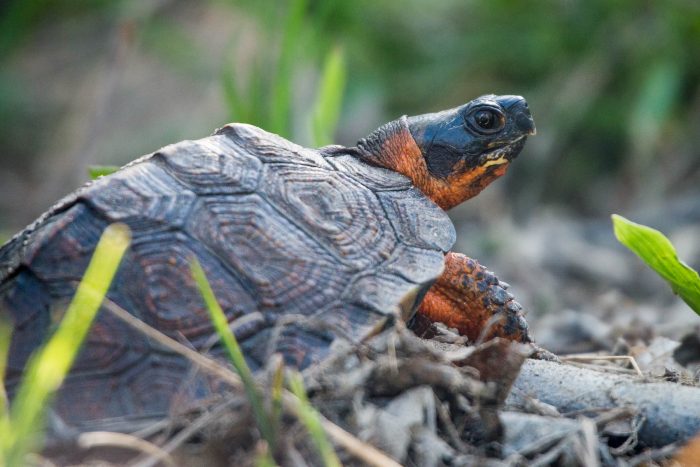Wood Turtle
Glyptemys insculpta
Wood turtles live in and near woodland streams. They have bright orange markings on their neck and legs.
This section shows one large critter image at a time. Use the thumbnails that follow to select a specific image to display here.

This gallery contains a grid of small thumbnails. Selecting a thumbnail will change the main image in the preceding section.
Appearance
Wood turtles have dark bodies with bright yellow or orange on their neck and the inside of their legs. The top of their heads is dark brown or black. Their shell is usually brown or black, but it can have spots or stripes of yellow. Their shell is made of circular growth rings that form small pyramid-like shapes. The bottom of the shell is yellow and has black markings around its edges. Males are slightly larger than females.
Feeding
Wood turtles are omnivores. Juvenile turtles tend to eat a higher protein diet than adults. They eat a variety of plants, insects and aquatic invertebrates.
Predators
Raccoons, skunks, opossums, otters, coyotes, foxes, ravens, crows and herons will eat wood turtle eggs or attack them as adults.
Reproduction and life cycle
Wood turtles reach sexual maturity when they are approximately 12 to 20 years old. Wood turtles mate in the fall and early spring. Females nest in late spring near streams. Females will lay a maximum of one clutch of eggs per year with each clutch containing seven to 11 eggs. The eggs hatch in late summer. The turtles will find an overwintering location by mid- to late October.
Did you know?
The wood turtle is designated as a Species of Greatest Conservation Need (SGCN) in the State Wildlife Action Plans of all the states in which they are native. They are considered endangered by the International Union for Conservation of Nature.
The rings on a wood turtle’s carapace, or shell, can be used to estimate their age.
Wood turtles will stomp their feet on the ground to imitate falling rain and the movement of moles, triggering worms to come to the surface where the turtles can easily eat them.
Sources and additional information
Wood Turtle - U.S. Fish & Wildlife Service
Wood Turtle - Orianne Society
Wood Turtle - Smithsonian
